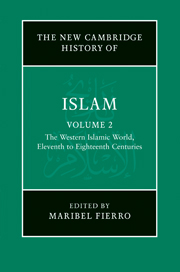Book contents
- Frontmatter
- Introduction
- PART I AL-ANDALUS AND NORTH AND WEST AFRICA (ELEVENTH TO FIFTEENTH CENTURIES)
- PART II EGYPT AND SYRIA (ELEVENTH CENTURY UNTIL THE OTTOMAN CONQUEST)
- PART III MUSLIM ANATOLIA AND THE OTTOMAN EMPIRE
- 10 The Turks in Anatolia before the Ottomans
- 11 The rise of the Ottomans
- 12 The Ottoman empire (tenth/sixteenth century)
- 13 The Ottoman empire: the age of ‘political households’ (eleventh–twelfth/seventeenth–eighteenth centuries)
- 14 Egypt and Syria under the Ottomans
- 15 Western Arabia and Yemen during the Ottoman period
- PART IV NORTH AND WEST AFRICA (SIXTEENTH TO EIGHTEENTH CENTURIES)
- PART V RULERS, SOLDIERS, PEASANTS, SCHOLARS AND TRADERS
- Glossary
- Bibliography
- Index
- References
14 - Egypt and Syria under the Ottomans
from PART III - MUSLIM ANATOLIA AND THE OTTOMAN EMPIRE
Published online by Cambridge University Press: 28 March 2011
- Frontmatter
- Introduction
- PART I AL-ANDALUS AND NORTH AND WEST AFRICA (ELEVENTH TO FIFTEENTH CENTURIES)
- PART II EGYPT AND SYRIA (ELEVENTH CENTURY UNTIL THE OTTOMAN CONQUEST)
- PART III MUSLIM ANATOLIA AND THE OTTOMAN EMPIRE
- 10 The Turks in Anatolia before the Ottomans
- 11 The rise of the Ottomans
- 12 The Ottoman empire (tenth/sixteenth century)
- 13 The Ottoman empire: the age of ‘political households’ (eleventh–twelfth/seventeenth–eighteenth centuries)
- 14 Egypt and Syria under the Ottomans
- 15 Western Arabia and Yemen during the Ottoman period
- PART IV NORTH AND WEST AFRICA (SIXTEENTH TO EIGHTEENTH CENTURIES)
- PART V RULERS, SOLDIERS, PEASANTS, SCHOLARS AND TRADERS
- Glossary
- Bibliography
- Index
- References
Summary
Introduction
The conquest of Syria in 922/1516 and of Egypt in 923/1517 by Sultan Selīm I (r. 917–26/1512–20) decisively altered the balance of power in the Middle East. The elimination of the Mamlūk sultanate and the incorporation into the empire of two of Islam’s former imperial capitals, Damascus and Cairo, strengthened the Ottoman dynasty’s position as the champion of Sunnī Islam at a time when their Safavid rivals were establishing Shīʿism as the religion of state in Iran. The sultan’s claim to be the heir apparent of the ʿAbbāsid caliphs was consolidated by the peaceful submission of Medina and Mecca to Selīm, following the fall of Cairo. The Muslim character of the Ottoman state was further enhanced by the demographic reality that Muslims had become the overwhelming majority of the sultan’s subjects for perhaps the first time in the empire’s history.
The reduction of Cairo and Damascus to provincial centres administered by a court that was at best forty-five days distant for an imperial messenger diminished their importance on the world stage and no Ottoman sultan after Selīm visited either. Yet Cairo was the political heart of the empire’s richest province and Damascus’ position as the starting point for the annual ḥajj caravan was crucial for the maintenance of the Ottoman sultan’s prestige as is demonstrated by one of his imperial titles, the ‘Servitor of the Two Holy Cities’ (khādim al-ḥaremeyn). Those at court in Istanbul could not be totally indifferent, therefore, to either city’s fate.
- Type
- Chapter
- Information
- The New Cambridge History of Islam , pp. 411 - 435Publisher: Cambridge University PressPrint publication year: 2010

